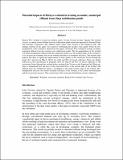Potential impacts of Kirinya wetland in treating secondary municipal effluent from Jinja stabilisation ponds
Author
Date
2004Type
Articleviews
downloads
Metadata
Show full item recordxmlui.dri2xhtml.METS-1.0.item-citation
Potential impacts of Kirinya wetland in treating secondary municipal effluent from Jinja stabilisation ponds Kansiime Frank1 and Mwesigye Patrick2 1Makerere University, Institute of Environment and Natural Resources, P.O. Box 7062, Kampala, Uganda 2 Makerere University, Department of Chemistry, P. O. Box 7062, Kampala, Uganda
Abstract/
Kirinya West wetland is located on northern shores of Lake Victoria in Jinja- Uganda. The wetland receives secondary treated effluent from the stabilisation ponds owned and operated by National Water and Sewerage Corporation. The effluent finally enters Lake Victoria at the Napoleon Gulf. The findings reported in this paper were aimed at establishing the baseline water quality before the biomanipulation of the wetland to demonstrate the impact of Kirinya West wetland in treating secondary municipal effluent from the existing waste stabilisation ponds. The bio-manipulation of the wetland will entail spreading the effluent from the stabilisation ponds over the northern edges of the wetland so as to increase the treatment area of the wetland and hence its treatment efficiency. The baseline data indicate that there is significant improvement of water quality as the wastewater flowed through the ponds (61% decrease in NH4-N, 46.9% for o-PO4 and 98% for faecal coliforms). There was further reduction in the concentration of pollutants (80% for NH4-N and 98% for faecal coliforms) as the wastewater flowed through the wetland before reaching Lake Victoria at the Napoleon Gulf. However, there is channelised flow and most of the wastewater flows at the western edge of the wetland. The effluent from the stabilisation ponds is discharged at the north–western edge of the wetland. Biomanipulation increases the current treatment efficiency of the wetland, as the contact between plants and the wastewater increases. The construction of the wastewater distribution system is underway

